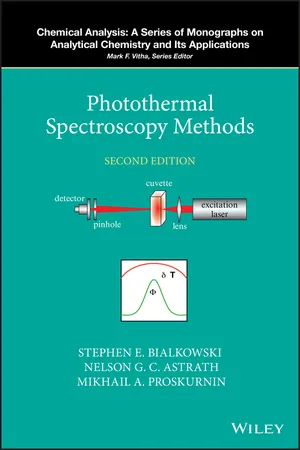
Photothermal Spectroscopy Methods
- English
- ePUB (mobile friendly)
- Available on iOS & Android
Photothermal Spectroscopy Methods
About This Book
Covers the advantages of using photothermal spectroscopy over conventional absorption spectroscopy, including facilitating extremely sensitive measurements and non-destructive analysis
This unique guide to the application and theory of photothermal spectroscopy has been newly revised and updated to include new methods and applications and expands on applications to chemical analysis and material science. The book covers the subject from the ground up, lists all practical considerations needed to obtain accurate results, and provides a working knowledge of the various methods in use.
Photothermal Spectroscopy Methods, Second Edition includes the latest methods of solid state and materials analysis, and describes new chemical analysis procedures and apparatuses in the analytical chemistry sections. It offers a detailed look at the optics, physical principles of heat transfer, and signal analysis. Information in the temperature change and optical elements in homogeneous samples and photothermal spectroscopy in homogeneous samples has been updated with a better description of diffraction effects and calculations. Chapters on analytical measurement and data processing and analytical applications are also updated and include new information on modern applications and photothermal microscopy. Finally, the Photothermal Spectroscopy of Heterogeneous Sample chapter has been expanded to incorporate new methods for materials analysis.
- New edition updates and expands on applications to chemical analysis and materials science, including new methods of solid state and materials analysis
- Includes new chemical analysis procedures and apparatuses
- Provides an unmatched resource that develops a consistent mathematical basis for signal description, consolidates previous theories, and provides invaluable insight into laser technology
Photothermal Spectroscopy Methods, Second Edition will appeal to researchers from both academia and industry (graduate students, postdocs, research scientists, and professors) in the general field of analytical chemistry, optics, and materials science, and researchers and engineers at scientific instrument developers in fields related to photonics and spectroscopy.
Frequently asked questions
Information
1
Introduction
1.1 Photothermal Spectroscopy
Table of contents
- Cover
- Table of Contents
- About the Authors
- Preface
- Acknowledgments
- 1 Introduction
- 2 Absorption, Energy Transfer, and Excited State Relaxation
- 3 Hydrodynamic Relaxation: Heat Transfer and Acoustics
- 4 Temperature Change, Thermoelastic Deformation, and Optical Elements in Homogeneous Samples
- 5 Photothermal Spectroscopy in Homogeneous Samples
- 6 Analytical Measurement and Data Processing Considerations
- 7 Analytical Applications
- 8 Photothermal Spectroscopy of Heterogeneous Samples
- Index
- End User License Agreement